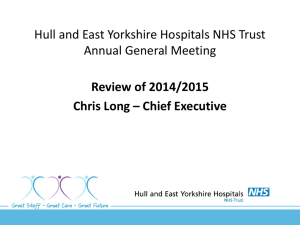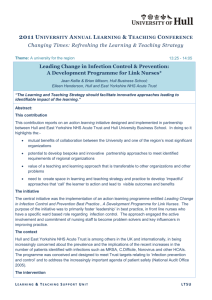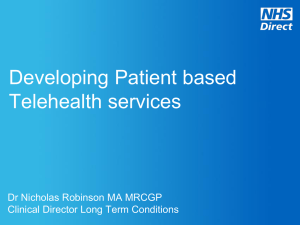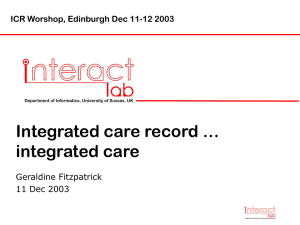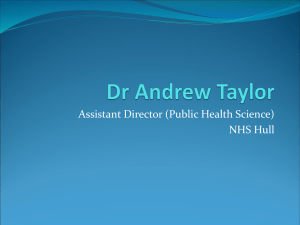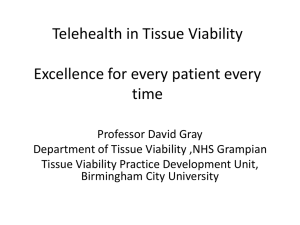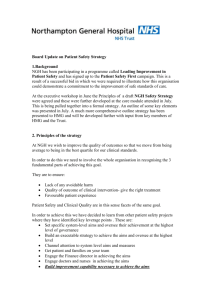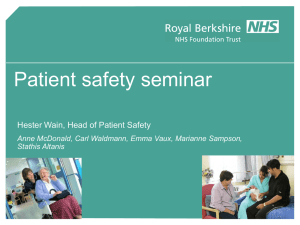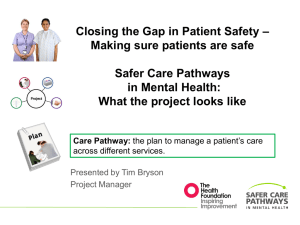Trust Future Plans - Hull and East Yorkshire Hospitals NHS Trust
advertisement
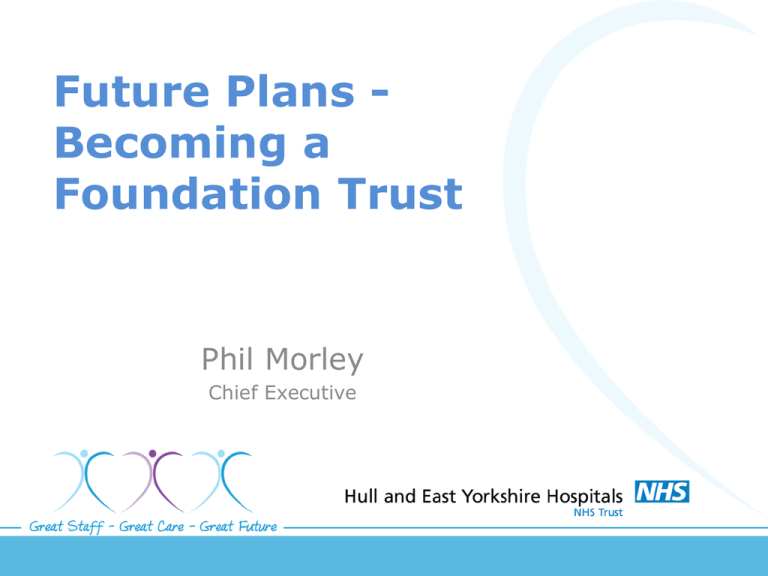
Future Plans Becoming a Foundation Trust Phil Morley Chief Executive Trust Vision ‘Great Staff, Great Care, Great Future’ • Our aims: – Deliver excellent quality outcomes and great patient experience; – Work in partnerships that add value and in ways that use public money wisely; – Have buildings that are fit for purpose; and – Provide assurance to our regulators and commissioners that all necessary standards are being met. We employ approx 7500 (WTE) staff Hull Royal Infirmary is mainly an emergency site, but also has women’s and children’s services, an Eye Hospital, and extensive Outpatient and Diagnostic services. Castle Hill Hospital is a mostly a site for planned patient care with some emergency cardiology services. There are also more Outpatient and Diagnostic Services based here. In 2010/2011 we saw: We provide medical and surgical services for approx 600,000 people In Hull and East Yorkshire. We also provide specialist services such as, cancer, neurosciences, cardiology, cardiothoracic surgery, renal medicine and dialysis to a wider geographical area in North Yorkshire and Lincolnshire. • 90,000 Emergency patients • 87,000 Elective (planned) patients • 154,000 New Outpatients GREAT CARE Quality and Safety Strategy The quality priorities for the Trust over the next five years are: Safety To reduce all avoidable deaths. To reduce all avoidable harm. Effectiveness To ensure the Trust always treats the right patient, in the right place, at the right time. To aspire to achieve the best clinical outcomes for all. Experience To improve communication through patient and staff engagement. Friends & Family Test “How likely are you to recommend this ward/department to friends & family if they needed similar care or treatment?” • • • • Ward Areas Emergency Department Outpatient Departments Maternity Services Compassion in Practice • • • • • • Transparency: Benching local & national Quality Boards at the entrance to every ward “you said” “we did” Intentional Rounding (Dec 2013) Chief Nurse agreeing appropriate staffing levels 6Cs in appraisals Setting the Standard Ward to Board Led by the Chief Nurse Clinical Areas are assessed against 12 Essential standards NHS Safety Thermometer No Patients % Harm Free New Harm Old Harm 1040 92.1 % 30 52 May 13 1038 June 13 1022 July 13 954 Augu st 13 962 94.6% 94.1% 94.1% 94.5% Septemb er 13 953 93.3% 18 28 30 22 19 38 32 26 30 49 Patients received HARM FREE CARE 95.33% Harm Free Care is defined as the number/percentage of patients who have not suffered any of the four harms measured by the safety thermometer before or since admission to hospital. Hospital Acquired Pressure Ulcer 70% Reduction and the percentage continues to reduce • • • Skin Care Bundle Trust wide Stricter control of interactive dressing Expected £50K savings by stopping inappropriate use of incontinence products ED First Phase (Opened May 2013) ED Children’s Reception ED Adults Self-Triage Kiosks ED Children’s Waiting ED Adults Waiting Area ED Second Phase (Autumn 2014) ED ‘Majors’ ED ‘Majors’ ED ‘Majors’ Waiting Area ED Majors Resuscitation Rooms Tower Block Encapsulation (May 2014) Old windows being removed from inside Windowsills and reveals to be finished in a high performanc e material New windows being installed from outside Improving our services • • • • • • • • • Stroke services Palliative care network Reconfiguration of Acute Assessment unit Accreditation as a Major Trauma Centre Transforming our surgical services Theatre improvement programme Pathway redesign Developing maternity services 59 Clinical Service Strategy Francis Report 290 recommendations 27 Key Recommendations to take forward by HEY 11 Prioritised • A Common set of Core Values & Standards • Assessing Core Values at interview • Supervisory Status for Ward Managers • E Observations • E Prescribing & Administration • Relative Surgeries on Wards • Promoting our desire to learn from comments / complaints Key R&D Strategic Objectives Patient Focus Partnership Working R&D Infrastructure Research Culture & Training Finance & Risk • Microfluidics ‘Lab-on-a-microchip system’ aims to understand how current treatments (i.e. chemotherapy and radiotherapy) respond to specific tumour types allowing to develop more individualised care to patients. A current project sponsored by HEY and funded by the European Commission looks at the use of the device to detect biomarkers in non-small cell lung cancer. Inflammatory Bowel disease is also being studied for microfluidic use. • Telehealth Telehealth is a broad term that refers to the use of technology to enable the remote delivery of healthcare or promotion of well-being. It is just one part of ‘eHealth’ – a term that also encompasses electronic patient records and other areas of health informatics. Working with the University of Hull, the Trust is playing an active role in supporting the bringing together of telehealth expertise from academia, primary and acute care, local authorities, industry and third sector partners that will form the future basis for telehealth service delivery in the NHS and elsewhere • Nasogastric Tubes Nasogastric tubes have been in existence since Egyptian times but until now, there has been no safe mechanism to ensure these tubes are inserted into exactly the right place. A team from the University of Hull working with colleagues in the Trust has set out to create a fail-safe detection mechanism for the placement of feeding tubes that is reliable and cheap to manufacture. Great Staff Communicating and engaging with our staff • No surprises! Tell staff before they find out from someone else • Be honest even if the message is difficult or unpopular • Make it easy for staff to find out information • Use face-to-face conversations • Invite staff to tell us how we can improve our services • Involve staff in decisions about changes which affect them • Help staff to deliver on the things they believe are important • Communicate the good things we do • Foster good relationships and partnership working with unions Big Conversations Over 1000 staff attended. Key themes identified and project teams allocated to deliver on the main issues Pioneer Teams – staff-led initiatives, championed by a Trust Director 20 teams have completed the programme • • • • • • • • • • • • • • A 70% increase in referrals in to the cancer survivorship service The creation of an IBD biologic unit in the gastroenterology ward Access to remote paperless working for all neurology nurses Hip fracture patients are now 28% less likely to die whilst in hospital One lift in HRI is now isolated for patient use only to improve privacy and dignity 6 out of 7 anaesthetic rooms in HRI theatres have been remodelled Patient therapy sessions to be scheduled through the Cayder boards A standardised Bereavement service has been developed for the relatives of deceased patients Freed up almost 20 hours a week for community midwives to spend with their patients Implemented significant changes to the catering services being provided to staff Telephone calls reduced by up to 30% on our pilot wards Improved recovery for breast care patients Four beds ring-fenced for neuro patients in ICU, resulting in fewer delays for patients Significant progress made towards reducing the amount of paper pathology results Great Leaders programme 240 of our managers to undergo the programme Each will learn how to empower and enable staff Are you a transformer? Each will deliver on their own personal commitment and improvement programme through Big Conversation engagement with their teams and colleagues Great Future Keeping Services Local Centralisation Tertiary services Specialist secondary services Specialist services will be concentrated in fewer centres (to increase quality of care), with some patients travelling for these ‘once in a lifetime’ events Unplanned care Routine secondary services Ambulatory care Localisation More routine services will be provided locally, with travel time for all patients minimised. These are services that patients may need to access frequently during their care pathway. Partnerships • Clinical Alliance with York Teaching Hospital NHS Foundation Trust (February 2013) • ‘Working Together for Our Future’ conference 8th November, bringing together clinicians from all specialties, in York and Hull • ‘Strategic conversations’ with Northern Lincolnshire and Goole Hospitals NHS Foundation Trust. Affordable Quality Service: The future in financial terms What does this mean for us? • Planning to deliver a 1% surplus each year requires a minimum of 5% increase in productivity and efficiency • Hugely challenging given the requirement to maintain and in some areas improve quality – eg: improve privacy and dignity in A&E • Will need to work increasingly in partnership with others, notably York FT and NLAG FT to develop stronger clinical networks for patients • Change is unavoidable given the numbers involved. We would prefer to be in control of that process rather than have it dictated to us • What is key is that all change will have to be directed by patient requirements Affordable Quality Services: future in financial terms The • Our aim is to provide the best quality services for the money that is available • It is vitally important that we have a stable financial platform from which we can deliver quality clinical services • Extremely challenging agenda: Estimated £30bn gap nationally by 2021 Acute Hospitals The Future Social Care Community Services ‘Technically Enabled’ • £20m investment supporting clinical excellence and collaborative working • Making it easy for clinicians and patients to take the right action, at the right time, with confidence • Getting rid of paper and joining things up so care professionals can look at whatever information they need, wherever they are working • Making it easier for our patients to access our services and engage with us using modern, user friendly technology • Reduce risks, deliver benefits, accelerate the pace of service transformation Our FT Application Become a Governor and be part of our future
